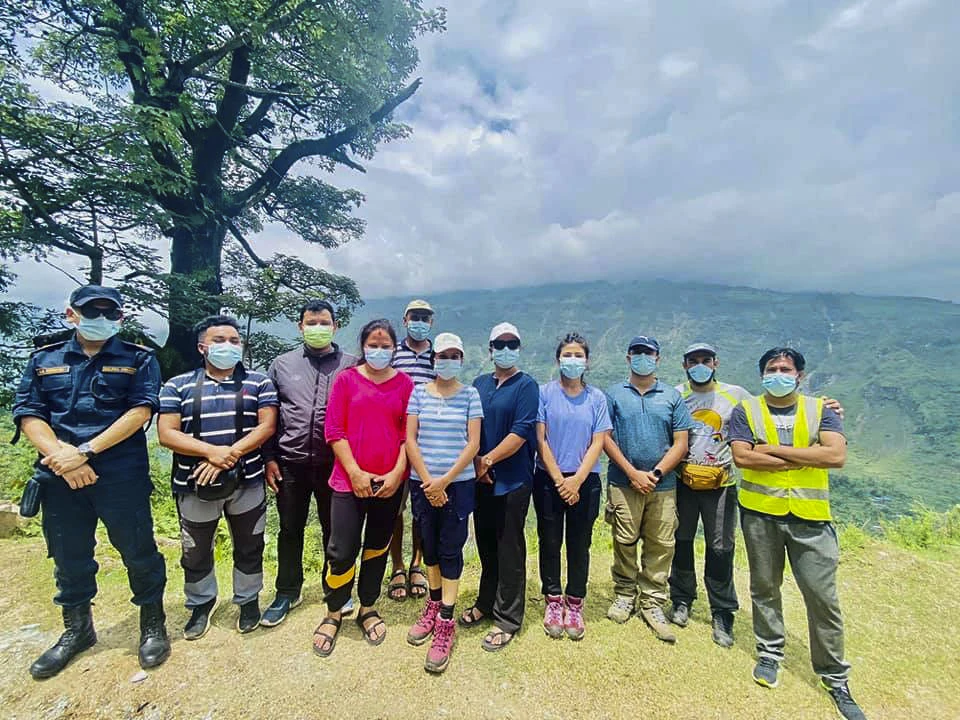Saving lives through geohazard assessments in Nepal
Published: Jul 27, 2021 Reading time: 3 minutes Share: Share an articleNepal’s Sindhupalchok District was one of the 14 districts most severely affected by the 2015 earthquake that devastated the country. The earthquake exacerbated the district’s longstanding problem with landslides, which are particularly prevalent during the monsoon season. In 2020, the monsoon triggered a landslide in Nagpuje, part of Sindhupalchok’s Barhabise Municipality, killing 14 people and displacing 62 families, while 17 people remain missing. The displaced families have spent the last year living in tents in a relocation camp, in constant fear of landslides and waiting to be relocated to safer areas by the local government.

To increase the resilience of Nepali communities in rural, mountainous regions through the mitigation and management of landslides, People in Need (PIN), together with its partners, including the Community Self Reliance Centre, the National Society for Earthquake Technology- Nepal, Scott Wilson Nepal, Durham University, and Northumbria University, with funding from the European Union, are implementing the “Risk-Informed Landslide Management in Nepal's Hill Areas Project,” or “Pratibaddha”.
Sanu Man Lama, who is displaced and living in the Nagpuje camp, says: “While staying in the relocation camp, we received food, clothes, cooking utensils, and a dignity kit from the government and non -governmental organisations. We also received support for the construction of temporary shelters and latrines, as well as access to drinking water. Although this support improved living conditions in the camp, all of this support is temporary. We cannot continue to live in the camp forever."
"This camp is not far from the landslide hazard site. We fear that the current camp will be swept away if there is more heavy rainfall. We expect the government to provide a permanent solution to the problem," he adds.
Assessing risks to save lives and livelihoods
As part of the Pratibaddha project, PIN is conducting a geohazard assessment in the Barhabise Municipality, in coordination with Nepal’s National Disaster Risk Reduction Management Authority (NDRRMA). The aim of the assessment is to evaluate the immediate risks from landslides so that mitigation measures or, in more extreme cases, the relocation of settlements to safer areas can be planned. These interventions will help reduce human fatalities as well as the loss of livelihoods and property. The assessment team includes a geologist, a geo-technical engineer, and a social expert, as well as representatives from the local authority and the police.
Sushila Pakhrin, Deputy Mayor of Barhabise, notes that despite a concerted effort, the municipality was not able to conduct geohazard assessments of areas affected by landslides in the past due to a lack of resources, tools, and support from the relevant authority. She says: "It proved difficult for us to formulate any Disaster Risk Reduction (DRR) plans, especially for the landslide-prone areas and landslide-affected settlements. We are grateful that the assessment is being conducted as part of the Pratibaddha project. We can use the reports to initiate evidence-based planning for all of the landslide-affected areas within the municipality."
Using categorisation to access relocation grants
The assessment team has been using the NDRRMA-approved 'Technical Guidelines to Conduct Field Investigation of Settlements Affected by Landslides Guideline 2077' to assess the areas selected for study. The assessed sites are being grouped into three categories− CAT 1, 2, and 3− where CAT 1 areas are deemed safe for settlement, CAT 2 areas will be safe after the adoption of landslide mitigation measures, and CAT 3 areas are considered unsafe and require relocation. These categorisations will enable CAT 3 beneficiaries to access relocation grants from the government, offering more permanent solutions to the recurring problem of landslides.
The assessment team has assessed 49 sites across eight, landslide-affected wards. In the coming months, similar assessments will be conducted in over 100 sites in Sindhupalchok District’s Bhotekoshi Rural Municipality, and in Dolakha District’s Bigu and Tamakoshi Rural Municipalities.



